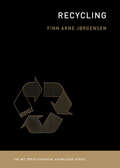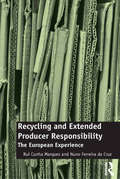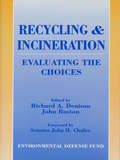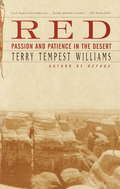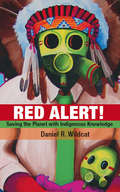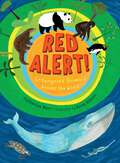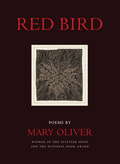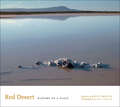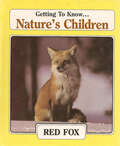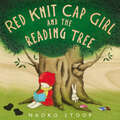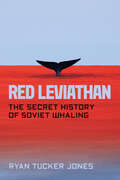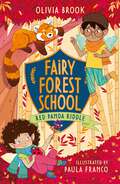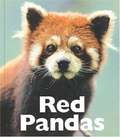- Table View
- List View
Recycling (The MIT Press Essential Knowledge Series)
by Finn Arne JorgensenAn overview of recycling as an activity and a process, following different materials through the waste stream.Is there a point to recycling? Is recycling even good for the environment? In this volume in the MIT Press Essential Knowledge series, Finn Arne Jørgensen answers (drumroll, please): it depends. From a technical point of view, recycling is a series of processes—collecting, sorting, processing, manufacturing. Recycling also has a cultural component; at its core, recycling is about transformation and value, turning material waste into something useful—plastic bags into patio furniture, plastic bottles into T-shirts. Jørgensen offers an accessible and engaging overview of recycling as an activity and as a process at the intersection of the material and the ideological. Jørgensen follows a series of materials as they move back and forth between producer and consumer, continually transforming in form and value, in a never-ceasing journey toward becoming waste. He considers organic waste and cultural contamination; the history of recyclable writing surfaces from papyrus to newsprint; discarded clothing as it moves from the the Global North to the Global South; the shifting fate of glass bottles; the efficiency of aluminum recycling; the many types of plastic and the difficulties of informed consumer choice; e-waste and technological obsolescence; and industrial waste. Finally, re-asking the question posed by John Tierney in an infamous 1996 New York Times article, “is recycling garbage?” Jørgensen argues that recycling is necessary—as both symbolic action and physical activity that has a tangible effect on the real world.
Recycling (World About Us)
by Tony HareDiscusses methods of recycling metal, plastic, paper, and glass, and why such conservation efforts are important.
Recycling For Dummies
by Sarah WinklerLearn the facts about recycling and discover the best way to make an impact Recycling is a simple action we can take that has an immediate positive effect. It keeps waste out of landfills, conserves natural resources, prevents pollution, and saves energy. Who wouldn’t want to do this? But recycling isn’t always straightforward. With so many different rules, it can be tough to work out the right thing to do. If you’re worried that you’re not recycling properly, or wondering whether you could be recycling more, this is the book for you. Recycling For Dummies cuts through the confusion around what you can and can’t recycle. This easy-to-follow manual breaks down recycling codes, symbols, and rules in a straightforward way that anyone can understand and apply. You’ll gain insight into the recycling process (where does that stuff go, anyway?) and learn tons of tips on reusing items in your daily life to cut down on waste. It also guides you on how to make smarter choices as a consumer to help preserve the planet for generations to come. Figure out what common materials can and can’t be recycled Understand what the recycling symbols are telling you Explore the many specialist recycling services available Learn what happens to your recyclables after they get picked up Become a true recycler by switching to recycled productsCheck out this book if you want to make your efforts count and be part of the recycling solution.
Recycling Institutions: How Waste Becomes an Urban Mine
by Brigt Dale Letícia Antunes Nogueira Håkan T. SandersenThis open access book investigates the phenomenon of recycling institutions in urban mining using social sciences lenses on the empirical context of waste from electrical and electronic equipment (WEEE), landfills as a potential resource pool and the recycling of building materials in Norway. There is a dual meaning to the term ‘recycling institutions’, and this book has the ambition to explore both. The first refers to institutions that recycle, i.e., the institutional infrastructure that facilitates material recycling. From household attitudes and practices to the laws and regulations that govern waste management, there is an institutional apparatus that recycling relies upon, which gains increased importance as the sustainability agenda develops. The second meaning refers to the recycling of institutions, in the sense that the institutional setup itself is being repurposed and transformed. This more metaphorical meaning points to the way in which emerging societal ambitions (such as the circular economy) stretch and bend existing institutions by imposing new functions upon them. Institutions are conservative and backward-looking and tend to resist rapid and radical changes that are incompatible with the ideas and practices they are built on. So, whereas the first is about designing new institutions for circularity, the second is about modifying and “recycling” existing institutions to meet the challenges circularity may entail. The central premise is that relevant, supportive and well-functioning institutional environments are crucial in the transition to a greener society that encourages industries, businesses, households and citizens to act in more sustainable ways, and it identify both possibilities and obstacles in the emergence of institutions that support urban mining. This book integrates a range of disciplines in the social sciences to investigate the phenomenon of recycling institutions. By examining the case of urban mining in Norway, with a special focus on how existing structures developed for waste management can be repurposed to facilitate this new function, the book provides insight into a scenario where material sourcing from anthropogenic sources is dissociated from natural resource scarcity and is instead linked to political ambitions and an attempt to stay at the forefront of sustainability transitions.
Recycling Reconsidered
by Samantha MacbrideRecycling is widely celebrated as an environmental success story. The accomplishments of the recycling movement can be seen in municipal practice, a thriving private recycling industry, and widespread public support and participation. In the United States, more people recycle than vote. But, as Samantha MacBride points out in this book, the goals of recycling -- saving the earth (and trees), conserving resources, and greening the economy -- are still far from being realized. The vast majority of solid wastes are still burned or buried. MacBride argues that, since the emergence of the recycling movement in 1970, manufacturers of products that end up in waste have successfully prevented the implementation of more onerous, yet far more effective, forms of sustainable waste policy. Recycling as we know it today generates the illusion of progress while allowing industry to maintain the status quo and place responsibility on consumers and local government. MacBride offers a series of case studies in recycling that pose provocative questions about whether the current ways we deal with waste are really the best ways to bring about real sustainability and environmental justice. She does not aim to debunk or discourage recycling but to help us think beyond recycling as it is today.
Recycling Reconsidered: The Present Failure and Future Promise of Environmental Action in the United States (Urban and Industrial Environments)
by Samantha MacbrideHow the success and popularity of recycling has diverted attention from the steep environmental costs of manufacturing the goods we consume and discard.Recycling is widely celebrated as an environmental success story. The accomplishments of the recycling movement can be seen in municipal practice, a thriving private recycling industry, and widespread public support and participation. In the United States, more people recycle than vote. But, as Samantha MacBride points out in this book, the goals of recycling—saving the earth (and trees), conserving resources, and greening the economy—are still far from being realized. The vast majority of solid wastes are still burned or buried. MacBride argues that, since the emergence of the recycling movement in 1970, manufacturers of products that end up in waste have successfully prevented the implementation of more onerous, yet far more effective, forms of sustainable waste policy. Recycling as we know it today generates the illusion of progress while allowing industry to maintain the status quo and place responsibility on consumers and local government.MacBride offers a series of case studies in recycling that pose provocative questions about whether the current ways we deal with waste are really the best ways to bring about real sustainability and environmental justice. She does not aim to debunk or discourage recycling but to help us think beyond recycling as it is today.
Recycling and Extended Producer Responsibility: The European Experience
by Rui Cunha Marques Nuno Ferreira CruzAn overriding value of European legislation on waste management is the Extended Producer Responsibility (EPR) principle. For example, all economic operators placing packaging onto the EU market are responsible for its proper management and recovery. However, in general, the collection and treatment of urban waste is the responsibility of local authorities. It has therefore been necessary to establish a system of financial compensations between producers and waste management operators. Analysing the legal and institutional schemes of several member states and accounting for all the costs and benefits to their local authorities due to selective collection and sorting, this book provides an accurate illustration of how the EPR principle has be translated into practice. Firstly the authors examine whether the industry is paying for the net financial cost of 'preparation for recycling' activities or if the extra-costs of recycling are being recovered via the sale of sorted materials, by the consumer through higher prices or by citizens in general through higher taxes. Secondly, by monetizing the net environmental benefits attained with the recycling system, the book discusses the success and Value-for-Money (VfM) of the EU’s recycling policy. In other words: what is the economic rate of return of the enhanced environmental protection achieved due to the fulfilment of recovery and recycling targets?
Recycling and Incineration: Evaluating The Choices
by John Ruston Richard Denison Environmental Defense FundRecycling and Incineration presents information on the technology, economics, environmental concerns, and legal intricacies behind recycling and incineration programs.
Recycling of Solid Waste for Biofuels and Bio-chemicals
by Subramanian Senthilkannan Muthu Obulisamy Parthiba Karthikeyan Kirsten HeimannThis book presents the latest advances in and current research perspectives on the field of urban/industrial solid waste recycling for bio-energy and bio-fuel recovery. It chiefly focuses on five main thematic areas, namely bioreactor landfills coupled with energy and nutrient recovery; microbial insights into anaerobic digestion; greenhouse emission assessment; pyrolysis techniques for special waste treatment; and industrial waste stabilization options. In addition, it compiles the results of case studies and solid waste management perspectives from different countries.
Recyclo-gami: 40 Crafts to Make your Friends GREEN with Envy!
by Laurie Goldrich WolfWhat can you make out of your old bits of paper, leftover pieces of yarn, or not-so-brand-new cartons and containers? Craft your own purse out of playing cards, whip up a scrapbook made of cereal boxes, or a dollhouse from an empty juice carton! Tweens and teens can start crafting using the easy to follow instructions and photographic directions the smart way. All crafts are made out of materials that many of us find just lying around the house or sitting on the curb waiting to be tossed in a landfill. Overpriced décor, fashion, and gifts are out, and recyclable crafts are in!
Red
by Terry Tempest WilliamsThe beloved author ofRefuge, Terry Tempest Williams is one of the country’s most eloquent and imaginative writers. The desert is her blood. In this potent collage of stories, essays, and testimony,Redmakes a stirring case for the preservation of America’s Redrock Wilderness in the canyon country of southern Utah. As passionate as she is persuasive, Williams writes lyrically about the desert’s power and vulnerability, describing wonders that range from an ancient Puebloan sash of macaw feathers found in Canyonlands National Park to the desert tortoise–an animal that can “teach us the slow art of revolutionary patience” as it extends our notion of kinship with all life. She examines the civil war being waged in the West today over public and private uses of land–an issue that divides even her own family. With grace, humor, and compassionate intelligence, Williams reminds us that the preservation of wildness is not simply a political process but a spiritual one. “Lush elegies to the wilderness. . . . Earthy, spiritual, evocative. ” —The Boston Globe “Erotic, scientific, literary. . . . Her intimacy with this landscape is complex and passionate. ” —Los Angeles Times Book Review “Her finest writing . . . Use[s] pure language in the face of laws that need to be changed and lawmakers and citizens who need to understand that there is another way to see. ” —Portland Oregonian
Red
by Terry Tempest WilliamsThe beloved author of Refuge, Terry Tempest Williams is one of the country's most eloquent and imaginative writers. The desert is her blood. In this potent collage of stories, essays, and testimony, Red makes a stirring case for the preservation of America's Redrock Wilderness in the canyon country of southern Utah. As passionate as she is persuasive, Williams writes lyrically about the desert's power and vulnerability, describing wonders that range from an ancient Puebloan sash of macaw feathers found in Canyonlands National Park to the desert tortoise-an animal that can "teach us the slow art of revolutionary patience" as it extends our notion of kinship with all life. She examines the civil war being waged in the West today over public and private uses of land-an issue that divides even her own family. With grace, humor, and compassionate intelligence, Williams reminds us that the preservation of wildness is not simply a political process but a spiritual one."Lush elegies to the wilderness. . . . Earthy, spiritual, evocative." --The Boston Globe"Erotic, scientific, literary. . . . Her intimacy with this landscape is complex and passionate." --Los Angeles Times Book Review"Her finest writing . . . Use[s] pure language in the face of laws that need to be changed and lawmakers and citizens who need to understand that there is another way to see." --Portland OregonianFrom the Trade Paperback edition.
Red Alert!
by Daniel R. Wildcat"Red Alert! offers insight, hope, and a path forward."--Billy Frank Jr., Chairman, Northwest Indian Fisheries Commission"What the world needs today is a good dose of indigenous realism," says Native American scholar Daniel R. Wildcat in this thoughtful, forward-looking treatise. The Native response to the environmental crisis facing our planet, Red Alert! seeks to debunk our civilization's long-misguided perception that humankind is at odds with nature or that it exerts control over the natural world.Taking a hard look at the biggest problem that we face today--the damaging way we live on this earth--Wildcat draws upon ancient Native American wisdom and nature-centered beliefs to advocate a modern strategy to combat global warming. Inspiring and insightful, Red Alert! is a stirring call to action.Daniel R. Wildcat (Yuchi, Muscogee) is the director of the American Indian studies program and the Haskell Environmental Research Studies Center at Haskell Indian Nations University in Lawrence, Kansas. He is the co-author with Vine Deloria Jr. of Power and Place: Indian Education in America and the co-author of Destroying Dogma: Vine Deloria Jr. and His Influence on American Society.
Red Alert! Endangered Animals Around the World
by Catherine BarrAn interactive look at endangered animals imploring readers to discover fifteen species facing extinction.Inspired and endorsed by the "Red List" database of animals in peril maintained by the International Union for the Conservation of Nature (IUCN) this brightly illustrated book introduces species from six different habitats on six continents. Blending approachable text, secondary facts and lush art, Red Alert! offers full portraits of animals such as the Chinese giant salamander, the snow leopard, the blue whale, and the giant panda, and provides young activists additional resources for how they can help save these beautiful creatures.
Red Bird
by Mary OliverMary Oliver's twelfth book of poetry, Red Bird comprises sixty-one poems, the most ever in a single volume of her work. Overflowing with her keen observation of the natural world and her gratitude for its gifts, for the many people she has loved in her seventy years, as well as for her disobedient dog Percy, Red Bird is a quintessential collection of Oliver's finest lyrics.
Red Desert: History of a Place
by Martin StupichA vast expanse of rock formations, sand dunes, and sagebrush in central and southwest Wyoming, the little-known Red Desert is one of the last undeveloped landscapes in the United States, as well as one of the most endangered. It is a last refuge for many species of wildlife. Sitting atop one of North America’s largest untapped reservoirs of natural gas, the Red Desert is a magnet for energy producers who are damaging its complex and fragile ecosystem in a headlong race to open a new domestic source of energy and reap the profits. To capture and preserve what makes the Red Desert both valuable and scientifically and historically interesting, writer Annie Proulx and photographer Martin Stupich enlisted a team of scientists and scholars to join them in exploring the Red Desert through many disciplines—geology, hydrology, paleontology, ornithology, zoology, entomology, botany, climatology, anthropology, archaeology, sociology, and history. Their essays reveal many fascinating, often previously unknown facts about the Red Desert—everything from the rich pocket habitats that support an amazing diversity of life to engrossing stories of the transcontinental migrations that began in prehistory and continue today on I-80, which bisects the Red Desert. Complemented by Martin Stupich’s photo-essay, which portrays both the beauty and the devastation that characterize the region today, Red Desert bears eloquent witness to a unique landscape in its final years as a wild place.
Red Desert: History of a Place
by Martin StupichA photographic and multidisciplinary study of one of America&’s last undeveloped—and most endangered—landscapes, edited by a Pulitzer Prize–winning author.A vast expanse of rock formations, sand dunes, and sagebrush in central and southwest Wyoming, the little-known Red Desert is one of the last undeveloped landscapes in the United States, as well as one of the most endangered. It is a last refuge for many species of wildlife. Sitting atop one of North America's largest untapped reservoirs of natural gas, the Red Desert is a magnet for energy producers who are damaging its complex and fragile ecosystem in a headlong race to open a new domestic source of energy and reap the profits.To capture and preserve what makes the Red Desert both valuable and scientifically and historically interesting, writer Annie Proulx and photographer Martin Stupich enlisted a team of scientists and scholars to join them in exploring the Red Desert through many disciplines: geology, hydrology, paleontology, ornithology, zoology, entomology, botany, climatology, anthropology, archaeology, sociology, and history. Their essays reveal many fascinating, often previously unknown facts about the Red Desert—everything from the rich pocket habitats that support an amazing diversity of life to engrossing stories of the transcontinental migrations that began in prehistory and continue today on I-80—which bisects the Red Desert.Complemented by Martin Stupich&’s photo-essay, which portrays both the beauty and the devastation that characterize the region today, Red Desert bears eloquent witness to a unique landscape in its final years as a wild place.
Red Dog/Blue Dog: When Pooches Get Political
by Chuck Sambuchino"Totally worth the Milk-bones I traded for it." -- Bo Obama"So hilarious I peed on the rug." -- Barney BushPolitics Goes to the Dogs Have you ever considered that man's best friend has political leanings just like we do? Red Dog / Blue Dog reveals that some tails wag to the left and others to the right! With 140 full-color photos of opinionated pooches accompanied by clever captions from the dogs themselves, this amusing book will add some much-needed levity to politics -- whatever side of the political spectrum you are on.
Red Fox (Nature's Children)
by Merebeth SwitzerDiscover many things about the Red Fox. The author describes the physical features, natural environment and habits of this, the most common of the foxes.
Red Gold: The Managed Extinction of the Giant Bluefin Tuna
by Jennifer E. TelescaIlluminating the conditions for global governance to have precipitated the devastating decline of one of the ocean&’s most majestic creatures The International Commission for the Conservation of Atlantic Tunas (ICCAT) is the world&’s foremost organization for managing and conserving tunas, seabirds, turtles, and sharks traversing international waters. Founded by treaty in 1969, ICCAT stewards what has become under its tenure one of the planet&’s most prominent endangered fish: the Atlantic bluefin tuna. Called &“red gold&” by industry insiders for the exorbitant price her ruby-colored flesh commands in the sushi economy, the giant bluefin tuna has crashed in size and number under ICCAT&’s custodianship.With regulations to conserve these sea creatures in place for half a century, why have so many big bluefin tuna vanished from the Atlantic? In Red Gold, Jennifer E. Telesca offers unparalleled access to ICCAT to show that the institution has faithfully executed the task assigned it by international law: to fish as hard as possible to grow national economies. ICCAT manages the bluefin not to protect them but to secure export markets for commodity empires—and, as a result, has become complicit in their extermination.The decades of regulating fish as commodities have had disastrous consequences. Amid the mass extinction of all kinds of life today, Red Gold reacquaints the reader with the splendors of the giant bluefin tuna through vignettes that defy technoscientific and market rationales. Ultimately, this book shows, changing the way people value marine life must come not only from reforming ICCAT but from transforming the dominant culture that consents to this slaughter.
Red Knit Cap Girl and the Reading Tree
by Naoko StoopThis new adventure with Red Knit Cap Girl and her friends uses simple prose and radiant illustrations to shine a light on the joy of reading and the importance of working together.One day Red Knit Cap Girl and her friends discover a hollow tree in the middle of the forest. What can be done with one ordinary tree? "I will keep my book in this nook so everyone can read it," Red Knit Cap Girl says.But the tree isn't only for books. Little by little, one by one, the animals share their unique gifts and turn the ordinary tree into a special spot for everyone to enjoy!
Red Knit Cap Girl to the Rescue
by Naoko Stoop'I hope it's not too far away,' says Red Knit Cap Girl. 'Follow the light of the Moon,' calls Owl. In this heartwarming follow-up to Naoko Stoop's debut Red Knit Cap Girl, Red Knit Cap Girl meets a lost Polar Bear Cub. Determined to help him find his way home, to an Arctic land of ice and snow, Red Knit Cap Girl, White Bunny, and Polar Bear Cub set off on an unforgettable voyage. Gorgeously illustrated on wood grain, Red Knit Cap Girl's curiosity, imagination, and joy will captivate the hearts of readers young and old. Simple prose and luminous pictures will remind readers that even small actions - such as recycling - can help to solve big world problems, in this inspiring story that celebrates friendship, bravery, and the importance of home.
Red Leviathan: The Secret History of Soviet Whaling
by Ryan Tucker JonesA revealing and authoritative history that shows how Soviet whalers secretly helped nearly destroy endangered whale populations, while also contributing to the scientific understanding necessary for these creatures’ salvation. The Soviet Union killed over six hundred thousand whales in the twentieth century, many of them illegally and secretly. That catch helped bring many whale species to near extinction by the 1970s, and the impacts of this loss of life still ripple through today’s oceans. In this new account, based on formerly secret Soviet archives and interviews with ex-whalers, environmental historian Ryan Tucker Jones offers a complete history of the role the Soviet Union played in the whales’ destruction. As other countries—especially the United States, Great Britain, Japan, and Norway—expanded their pursuit of whales to all corners of the globe, Stalin determined that the Soviet Union needed to join the hunt. What followed was a spectacularly prodigious, and often wasteful, destruction of humpback, fin, sei, right, and sperm whales in the Antarctic and the North Pacific, done in knowing violation of the International Whaling Commission’s rules. Cold War intrigue encouraged this destruction, but, as Jones shows, there is a more complex history behind this tragic Soviet experiment. Jones compellingly describes the ultimate scientific irony: today’s cetacean studies benefited from Soviet whaling, as Russian scientists on whaling vessels made key breakthroughs in understanding whale natural history and behavior. And in a final twist, Red Leviathan reveals how the Soviet public began turning against their own country’s whaling industry, working in parallel with Western environmental organizations like Greenpeace to help end industrial whaling—not long before the world’s whales might have disappeared altogether.
Red Panda Riddle: Book 5 (Fairy Forest School #5)
by Olivia BrookA magical fairy school series about helping animals and looking after nature, from the publisher of the best-selling series, Rainbow Magic!It's autumn at Oakwings Academy, the magical school for Forest Fairies, and Poppy Merrymoss is learning how to make plants grow. Just as she's getting the hang of it, mean Lady Nightshade appears and puts a curse on the forest, covering it in a choking knot weed that stops plants growing. Poppy and her friends rush to clear the weeds and discover a lost red panda trapped beneath them. They need to help the baby panda get home but he's talking in riddles and they can't understand anything he says! Can they solve the riddles in time to get him home and save the rest of the forest from Lady Nightshade's curse?Have you read Poppy Merrymoss's other adventures, Fairy Forest School: The Raindrop Spell, Fairy Forest School: Baby Bunny Magic, Fairy Forest School: The Snowflake Charm and Fairy Forest School: Red Panda Riddle?
Red Pandas
by Joshua RuttenWhat do red pandas look like? Where do they live? How big is a red panda? Do red pandas have claws? Find the answers to those questions and learn much more about the physical characteristics, behavior, habitat, and life cycle of the small long-tailed red panda of Asia. All images are described.
